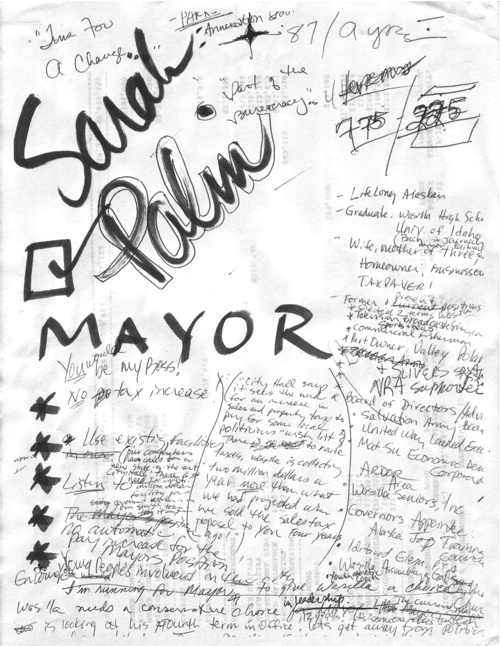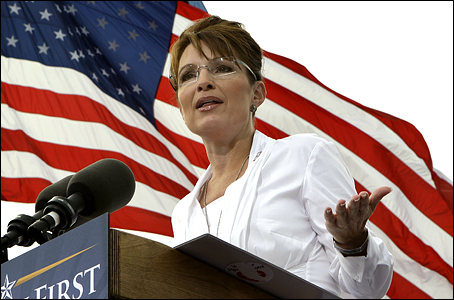Notes
What The Palin Doodle Document Suggests About How She Got Through The V.P. Debate
Like the Ulysses strategy for dealing with sirens, I’m convinced that the safest way to encounter Sarah Palin is by reading the transcript of comments she happens to spontaneously offer in public — however few and far between. Based on a couple of interviews, as well as her debate with Joe Biden, the discrepancy between how she comes off on TV as opposed to on paper is, simply put, mind blowing. In spite of how palatable she was on stage during the V.P debate, the written narrative — reminiscent of the Couric interview — careens back-and-forth between awkward and barely coherent.
With all that in mind, I’ve been looking at the “Palin doodle document” that has been floating around the past few days, and find it really fascinating — especially in light of that Veep debate. The note was provided to The New Republic by a woman named Laura Chase. According to Chase — who was a colleague of Palin’s on the Wasilla city council and Palin’s campaign manager in her first mayoral race — Palin scribbled these notes on the back of a City Hall budget passed out during a 1996 Wasilla City Council meeting.
The TNR post doesn’t offer much insight into the note itself — except to call attention to the bulleted points on the right, in which Palin outlines her qualifications for running for mayor. It’s the information in the middle and the bottom of the document, however, which I find most relevant. I believe the sample, in fact, might actually help us understand what Palin was doing during her debate with Biden.
If you look at my post on the V.P. debate, my third point offers screen shots of Palin writing and also looking down and reading. As I wrote:
Palin, the former sportscaster, did an impressive job sounding spontaneous while working from a combination of rote memory, as well what seemed like both pre-written and written notes. The delivery was pretty good, although the lack of follow-up questions allowed her to avoid most specificity and change the subject at will. If you watched Palin when she wasn’t speaking though, you’ll see she spent almost the entire debate making notes.
(Like Bush, I think Palin is probably quite skilled at working off a combination of memory and a written script. Apparently, she thought she could get away with same in the Couric interview, but didn’t expect follow-ups asking for specifics and examples.)
Considering the Wasilla document in the context of Palin’s behavior at the debate the other night, let’s take a look at the passage above in the middle of the page. It reads:
“City Hall says it sees the need for an increase in sales and property tax to pay for some local politicians “wish list.” There is no need to raise taxes. Wasilla is collecting two million dollars a year more than what we had projected when we sold the sales tax proposal to you four years ago!”
If you notice, the passage not only relates to City Hall business, but specifically to the budget. I’d be willing to bet — if a transcript could be found from that City Council meeting — that Palin spoke these three complete sentences out loud to the council after writing them down for herself. Supporting the assumption, notice how Palin actually encloses the sentences in quotation marks; adds guidelines for emphasis with underlines and exclamation marks; adopts a rhetorical confrontational tone; and also ends with emphatic punch.
Now, compare the strategy suggested by this twelve-year-old sample with how Palin dealt with the Biden debate.
Given how Palin was eagerly writing almost every moment she wasn’t speaking; and given that she and Biden were allowed pen and paper but weren’t allowed to bring pre-written notes; and given that most of her responses also ended with an emphatic punch (or a “zinger,” as she called it); and also given that throughout the transcript of the V.P. debate, you can see instances where Palin sounds more coherent for a sentence or two before descending back into disjointed fragments or sentences without clear beginnings, middles or ends, it seems reasonable to assume that Palin — having some kind of confidence problem, perhaps — approaches most extemporaneous speaking by either a.) avoiding it altogether, b.) having everything written out in advance, or c.) relying on rote memory, and scripting as much as possible on-the-spot.



Reactions
Comments Powered by Disqus